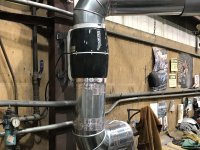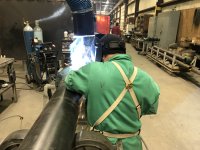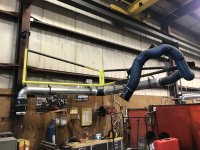user.69169
Veteran Member
- Joined
- Feb 22, 2009
- Messages
- 1,346
You procrastinator boys best get careful wid dat procedure. Way tings are dese days wid all de masked people runnin loose some prosecutor might call it premeditation and even conspiracy if you post bout de plans.
Compressor-
Get de intake 13 feet above ground, or high as you can, no hydrocarbon fumes. Dat why dive air machines suck from high up.
Can't penetrate de wall for intake run it out into soffit.
Make intake pipe at least 2x diameter of compressor intake size.
Scrap de Donaldson intake "filter" and replace wid a prechamber sized to primary piston volume. Put a housing in front of prechamber loosely stuffed wid chore boy SS sponges wid a few drops peanut oil on em to keep bugs out de machine and filter incoming air. Wash & reoil every 45 days, peanut plasticizes.
If you got 3600 rpm machine not even God can make it quiet.
Hang de machine from roof and gain floor space, make sure springs under de machine only half compress wid machine weight. Dat how dental office machines are built to kill sound.
If you wall machine in, you got a lot of heat to shed. Cuple mover blankets hung around machine like shower curtains kill off lot of sound and shaped right become chimney conducting heat up.
Use rubber hose to connect tank to pipe system. Do NOT use plastic hydraulic hose.
PEX will carry 150psi compressed air and PEX is cheaper den copper or iron.
Compressor-
Get de intake 13 feet above ground, or high as you can, no hydrocarbon fumes. Dat why dive air machines suck from high up.
Can't penetrate de wall for intake run it out into soffit.
Make intake pipe at least 2x diameter of compressor intake size.
Scrap de Donaldson intake "filter" and replace wid a prechamber sized to primary piston volume. Put a housing in front of prechamber loosely stuffed wid chore boy SS sponges wid a few drops peanut oil on em to keep bugs out de machine and filter incoming air. Wash & reoil every 45 days, peanut plasticizes.
If you got 3600 rpm machine not even God can make it quiet.
Hang de machine from roof and gain floor space, make sure springs under de machine only half compress wid machine weight. Dat how dental office machines are built to kill sound.
If you wall machine in, you got a lot of heat to shed. Cuple mover blankets hung around machine like shower curtains kill off lot of sound and shaped right become chimney conducting heat up.
Use rubber hose to connect tank to pipe system. Do NOT use plastic hydraulic hose.
PEX will carry 150psi compressed air and PEX is cheaper den copper or iron.
Last edited:



